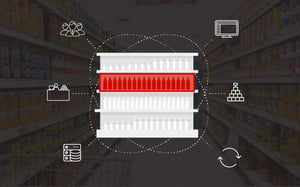Other than their products, the consistency across store layouts has contributed towards Apple’s cult-like following. Customers have the expectation that they will be consistent across all stores and every interaction - an expectation Apple has met with significant effect. When a customer visits an Apple store in London, they can expect it to look the same as the Apple store back home in Tokyo.
Apple is certainly an exceptional example but it does support the argument that consistency is important when it comes to how a retail brand is perceived. For those retailers who are aspiring towards greatness we suggest starting with a consistent Store layout which is the design of a store's floor space and the positioning of categories and items within that store. Consistent store layouts have a significant impact on how customers perceive a retailer’s brand image, specifically when it comes to these values:
1. Trust
A retailer with consistent store layouts, regardless of location, gives the retailer’s brand a personality in the eyes of the customer, someone they know they can trust and depend on.
2. Recognition
Consistency indicates clarity and purpose – there’s no confusion as to who they are, what they do for customers and what customers can expect them to deliver.
3. Quality
Retailers with consistent store layouts have taken the time to pay attention to detail – customers come to know that retailers who pay attention to detail in this way will deliver on quality.
In today’s retail market, customers will not buy from you just because you’ve got great products, reasonable prices or because you carry their choice brands. Customers will buy from you when your retail brand connects with them emotionally. As a retailer, you have the ability to do so, and in this post, we’ll cover some specific things which will help you get started with layout consistency.
Staple down your consumer decision tree
The consumer decision tree, which groups products according to how customers shop them, is a vital tool for retailers and manufacturers when designing store layouts through planograms.
When browsing a category in-store here is an example of a decision process a customer may go through:
1. Brand
Buying by brand is often the first stop for customers in a category because of the promise of quality and consistency.
2. Quality
The customer then segments the product into economy, premium and super-premium.
3. Attributes
At this stage, the customer segments even further by looking for attributes which meet their preference such as colour, flavour, or packaging.
The better designed and recorded a consumer decision tree is, the easier it will be for customers to shop. Consumer decision trees also impact space planners, the architects of store layouts. When products are classified according to their logical place on the consumer decision tree, space planners are better able to create planograms for more consistent layouts across multiple stores. If well executed, they make the difference between a fiercely loyal customer and an occasional shopper.
Learn more about some of the things which you can’t do without the consumer decision tree here.
Merchandising principles
Merchandising principles have a real impact on store layouts and in turn have a direct influence on the behaviour and perceptions of its customers. From a store layout consistency perspective take a look at the example regarding House Brands below:
In today’s market, many retailers develop their own house brands in an effort create connections with customers. The brand is often the first factor which influences a customer’s shopping behaviour, and it can be leveraged to create perceptions. To do this successfully, you’ll need to ensure your house brand is optimally placed. So if for example, if you made it a merchandising principle or “rule” to always put your house brand between the brand leader and the secondary brand on all shelves and in all stores it would contribute towards consistency. It would also improve the perceived value of your house brand.
Base Range
Depending on your store type, when customers shop at your store they expect there to be certain products available no matter what. These products are referred to as the base range. Products in the base range will stay the same across all your retail stores regardless of local preferences. The base range will usually comprise of the most popular products and brands that your shoppers expect to find across all your stores. For example, grocers who have a cereal category will almost always have Cornflakes, be it Kelloggs or house brand. This consistency puts customers at ease, letting them know that they can trust your store to have the essentials they need.
Conclusion
Focusing on the consistency of your store's layout will boost the way people perceive your brand.


